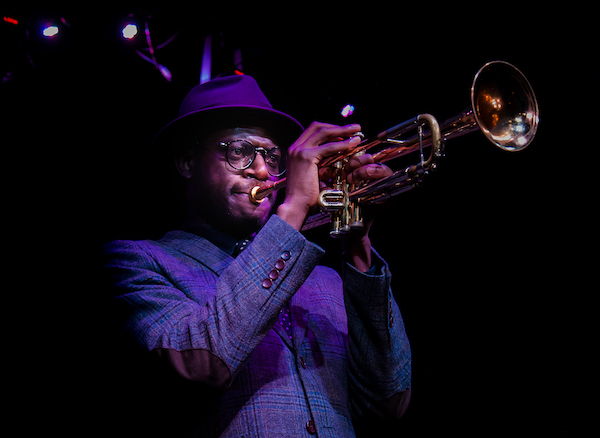Apr 2, 2024 12:59 PM
Saxophonist, Sonic Explorer Casey Benjamin Dies at 45
Casey Benjamin, the alto saxophonist, vocalist, keyboardist and producer who stamped his distinctive sounds on the…

Mark Kavuma’s sophomore album, The Banger Factory, places him at the center of London’s rapidly expanding jazz scene.
(Photo: Courtesy Ubuntu)Great art can emerge from any residency. A staple of jazz through the decades—from Ornette Coleman’s 1959 series at New York’s Five Spot to Steam Down’s raucous weekly jam at London’s Matchstick Piehouse today—the residency provides a simultaneously safe and challenging space to develop new songs and, crucially, gauge the reaction of fans.
That rich tradition is in full bloom on Thursday nights at the Prince of Wales pub in London’s Brixton neighborhood. That’s where 26-year-old trumpeter Mark Kavuma takes the stage with his Banger Factory band and routinely whips the room into a frenzy with a mix of standards and original compositions.
“Ninety percent of my songs are about a person or a place,” Kavuma said on a recent day in London. “It’s all driven through emotion and story. The residency has become the perfect place to test material. If it doesn’t bang, you know because the people aren’t dancing. And if it does bang, there’s no better feeling.”
Kavuma’s sophomore album, The Banger Factory (Ubuntu), places him at the center of London’s rapidly expanding jazz scene, which also includes saxophonists Shabaka Hutchings and Nubya Garcia, and tuba player Theon Cross.
Kavuma met Cross and other jazz players, like trumpeter Sheila Maurice-Grey, as a teenager in the performance troupe Kinetika Bloco. “There was such a fun, communal feel to Kinetika,” he recalled. “Anyone could come and play—it didn’t matter how good you were—and it was amazing to see everyone develop together. We’re now touring the world and releasing records and yet still finding the time to go back and teach.”
Kavuma has nine cousins who are a part of Kinetika, paving the way for yet another generation of jazz players. “So much of the London scene is influenced by Kinetika—the sense of fun that [founder] Mat Fox would bring, that’s the energy you see onstage with people like Ezra Collective or Theon Cross now,” Kavuma said.
Fox died of a heart attack in 2014, and his is an unsung legacy, in Kavuma’s opinion. “There are so many mentors and leaders who have shaped us, from Mat to Gary Crosby, who leads [the jazz education organization] Tomorrow’s Warriors, and my own school music teacher, Joe Morgan,” Kavuma said. “These people all fought and continue to fight for musical education when there’s no funding for it and little glory in it.”
A sense of community clearly is conveyed in Kavuma’s work. During the 2018 recording sessions for The Banger Factory, Kavuma brought nearly 20 compositions to the studio—each one written for a specific member of his octet. “We know each other so well through the residency now, we know exactly how to play each composition without me even having to say,” he explained.
The result is the Ellington-like melodic softness of the ballad “Mussinghi,” the funky fusion of the title track and the big band grandeur of “Mrakpor.” (Each of the aforementioned tunes is named after a band member.)
“Mark has such a unique sound on the horn,” said pianist and organist Reuben James, who also contributes to the album. “He lets it all hang out in a very vulnerable way when he plays ballads and with such tasteful arrangements for an eight-person band.”
There is everything from Wynton Marsalis’ controlled precision to Roy Hargrove’s gutsy soul and Louis Armstrong’s bright optimism in Kavuma’s playing. Still, his greatest strength is in leaving space for his bandmates, as evidenced by vibraphonist David Mrakpor’s languid solo on his namesake tune and Mussinghi Brian Edwards’ tenor saxophone harmonies on his.
“We’ve got so much music,” Kavuma enthused. “Since we’ve been playing together for so long, it all feels so natural—and there is much more to say. We’re going back into the studio to record another album in October and it’s only onwards and upwards from here.” DB

Benjamin possessed a fluid, round sound on the alto saxophone, and he was often most recognizable by the layers of electronic effects that he put onto the instrument.
Apr 2, 2024 12:59 PM
Casey Benjamin, the alto saxophonist, vocalist, keyboardist and producer who stamped his distinctive sounds on the…

“He’s constructing intelligent musical sentences that connect seamlessly, which is the most important part of linear playing,” Charles McPherson said of alto saxophonist Sonny Red.
Feb 27, 2024 1:40 PM
“I might not have felt this way 30 to 40 years ago, but I’ve reached a point where I can hear value in what people…

Albert “Tootie” Heath (1935–2024) followed in the tradition of drummer Kenny Clarke, his idol.
Apr 5, 2024 10:28 AM
Albert “Tootie” Heath, a drummer of impeccable taste and time who was the youngest of three jazz-legend brothers…

“Both of us are quite grounded in the craft, the tradition and the harmonic sense,” Rosenwinkel said of his experience playing with Allen. “Yet I felt we shared something mystical as well.”
Mar 12, 2024 11:42 AM
“There are a few musicians you hear where, as somebody once said, the molecules in the room change. Geri was one of…

Henry Threadgill performs with Zooid at Big Ears in Knoxville, Tennessee.
Apr 9, 2024 11:30 AM
Big Ears, the annual four-day music celebration that first took place in 2009 in Knoxville, Tennessee, could well be…